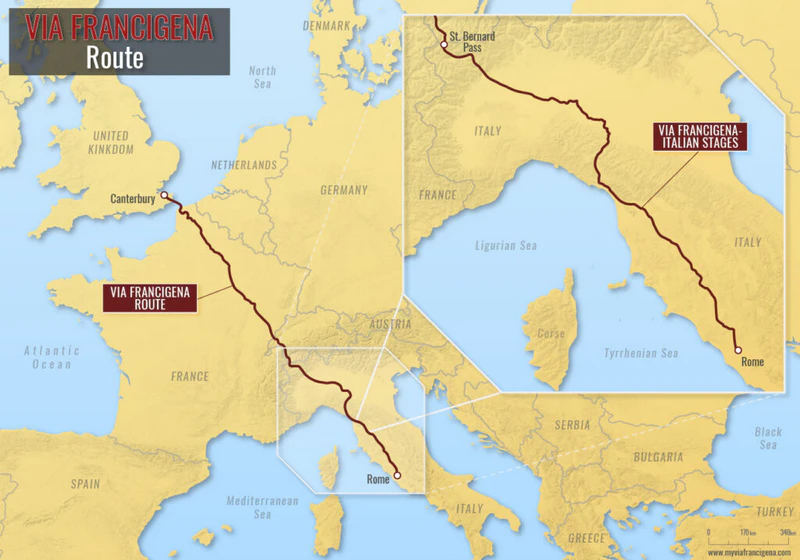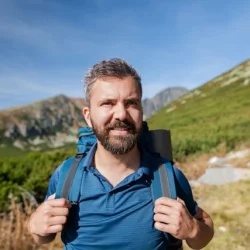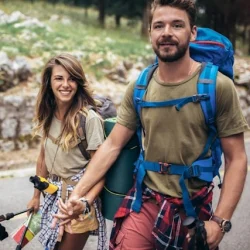About the Via Francigena
Everything You Need to Know About the Via Francigena
What is the Via Francigena?

A Legendary Route
A Journey Through History
An Immersive Experience
Why Walk the Via Francigena?
Highlights on the Via Francigena
Here is a small sample of the highlights pilgrims can expect while on the Via Francigena:
The Great St. Bernard Pass
A stunning alpine crossing marking the gateway into Italy, surrounded by dramatic mountain scenery.
Aosta Valley
Home to Roman ruins, medieval castles, and breathtaking mountain vistas.
Medieval Villages of Piedmont & Emilia-Romagna
Wander through charming stone-built towns like Ivrea, Fidenza, and Piacenza, rich in history and local traditions.
Tuscany’s Rolling Hills & Vineyards
Enjoy the picturesque landscapes of Chianti and Val d’Orcia, dotted with cypress-lined roads and world-renowned wineries.
Siena
A UNESCO-listed city with its striking Piazza del Campo and stunning Gothic cathedral.
San Quirico d’Orcia & Bagno Vignoni
Delight in historic villages and ancient thermal baths, once frequented by pilgrims and nobility alike.
Lake Bolsena
A tranquil volcanic lake with charming lakeside towns and historic monasteries.
Viterbo
The City of Popes, known for its medieval quarter and rejuvenating thermal springs.
The Final Steps into Rome
Walk through the countryside of Lazio before reaching St. Peter’s Basilica, a climactic and emotional end to the journey.
Walking the Via Francigena
Via Francigena Section 1: Saint Bernard Pass to Ivrea
Via Francigena Section 2: Ivrea to Pavia
Via Francigena Section 3: Pavia to Fidenza
Via Francigena Section 4: Fidenza to Pontremoli
Via Francigena Section 5: Pontremoli to Lucca
Via Francigena Section 6: Lucca to Siena
Via Francigena Section 7: Siena to Montefiascone
Via Francigena Section 8: Montefiascone to Rome
Cycling the Via Francigena
Check out the 3 cycling sections of the Via Francigena:
Via Francigena Section 1: Saint Bernard Pass to Parma
Via Francigena Section 2: Parma to Siena
Via Francigena Section 3: Siena to Rome
Resources to Plan Your Via Francigena Trip
Weather on the Via Francigena Pilgrimage
Season Overview
Season
Weather Conditions
Best for Pilgrims?
Spring (March–May)
occasional rain, blooming landscapes
Excellent
Comfortable temperatures, fewer crowds
Summer (June–August)
particularly in Italy; occasional storms in the Alps
Challenging
High heat in Tuscany and Lazio, but Alpine sections are pleasant
Autumn (September–November)
colorful scenery, occasional showers
Ideal
Comfortable temperatures and fewer tourists
Winter (December–February)
snow in the Alps, rainy in Tuscany and Lazio
Difficult
Snowy mountain passes and wet conditions
Key Takeaways
- Best Time to Walk: Spring and autumn offer the most pleasant weather with moderate temperatures and less tourist congestion.
- Challenging Periods: Summer can be extremely hot, especially in central Italy, while winter poses risks due to snow and rain.
- Weather Gear Tips: Pack lightweight, breathable clothes for summer; waterproof layers for spring and fall; and thermal gear for winter hikes in the Alps.
Via Francigena Packing List
Here are a few guidelines to get started:
- Base Layers – Moisture-wicking shirts (long & short sleeve)
- Mid Layers – Lightweight fleece or merino wool sweater
- Outer Layer – Waterproof & windproof jacket
- Bottoms – Quick-dry hiking pants & shorts
- Undergarments – Breathable socks & underwear (merino wool recommended)
- Hat & Gloves – Sun hat for summer, lightweight gloves for cooler months
- Hiking Boots or Trail Runners – Well-broken-in, with good ankle support
- Camp/Evening Shoes – Lightweight sandals or sneakers for rest stops
- Hiking Socks – At least 3 pairs of moisture-wicking socks
- Backpack – 30-50L with hip support (aim for lightweight)
- Daypack (Optional) – For short excursions or carrying valuables
- Walking Poles – Help with steep terrain and reduce joint strain
- Water System – Reusable water bottle or hydration bladder (1.5L minimum)
- Sleeping Bag Liner – Useful for hostel stays
- First Aid Kit – Bandages, pain relievers, blister care
- Sunscreen & Lip Balm – SPF protection for long walking hours
- Quick-Dry Towel – Compact & lightweight
- Toiletries – Travel-size soap, toothbrush, deodorant, etc.
- Earplugs & Eye Mask – Essential for hostel stays
- Phone & Power Bank – With local SIM or offline maps
- Notebook & Pen – For journaling or stamping your pilgrim passport
- Pilgrim Credential – Required for access to pilgrim accommodations
- ID & Travel Insurance – Copies stored in different locations
- Keep it light – Aim for a pack weight of 10% of your body weight
- Test your gear – Walk with your full pack before departure
- Plan for weather changes – Pack versatile layers
Why Choose My Via Francigena?
Authentic Experiences
Connect with the history, culture, and cuisine of Italy with itineraries that immerse travellers in the heart of the Italian landscape and way of life.
Freedom & Flexibility:
Our self-guided tours allow you to travel on your own terms, without the pressure of keeping up with a group.

World-Class Support
From the early stages of planning your adventure to your last steps walking the trail - get unbeatable support throughout your Via Francigena journey.
Backed by 10Adventures:
Benefit from our parent company’s track record of delivering unforgettable self-guided trips across the globe.
Hear from Our Travelers

“Walking the first stage of the Via Francigena on my own this summer was honestly one of the best adventures of my life!”
Sylvia
Stage 1: Saint Bernard Pass to Ivrea

“Crossing the Apennines and looking out across the terrain ahead was a surreal feeling. I can’t wait to plan my next walk along the Via Francigena.”
Davide
Stage 4: Fidenza to Pontremoli

“We absolutely fell in love with the Italian countryside, and the walk into Rome was an unforgettable experience.”
Andrew & Jaime
Stage 8: Montefiascone to Rome
